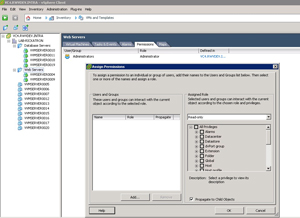vSphere Folder Organization Tip
vSphere has many options for administrators to organize hosts, clusters, virtual machines and all of the supporting components of the virtualized infrastructure. I was talking with a friend about how it is always a good idea to review and reorganize the virtualized infrastructure (see
Virtualization Housekeeping 101) and the topic of resource pools came up. I still find people who use a DRS resource pool as an organizational unit instead of the vSphere folder.
The DRS resource pool is not an organizational unit, but a resource allocation unit. Sure, the resource pool can be created with no reservations or limits, making no perceived impact on the available resources; but the parent-to-child pool chain is modified with the pool in place. The vSphere folder can contain datacenters, hosts, clusters, virtual machines and other folders.
The beauty of the vSphere folder is it can have its own permissions configuration. By default, it inherits the permissions from the parent; but it can be configured for explicit permissions. Fig. 1 shows a folder of Web servers and the ability to assign permissions for that collection of virtual machines.
 |
|
Figure 1. Permissions can be extended to folders to function as containers for roles or simply organizing virtual machines. (Click image to view larger version.) |
I find myself using the permissions of a folder to function like a group membership assignment that follows in the Active Directory world. The role functionality of vSphere allows the administrator to delegate a lot to different categories of users of a virtual machine. This can be as simple as view the virtual machine console, allow virtual media mount capabilities or even the virtual power button.
Do you use the folder for organization or permissions? If so, share how you use it here.
Posted by Rick Vanover on 10/28/2010 at 12:48 PM